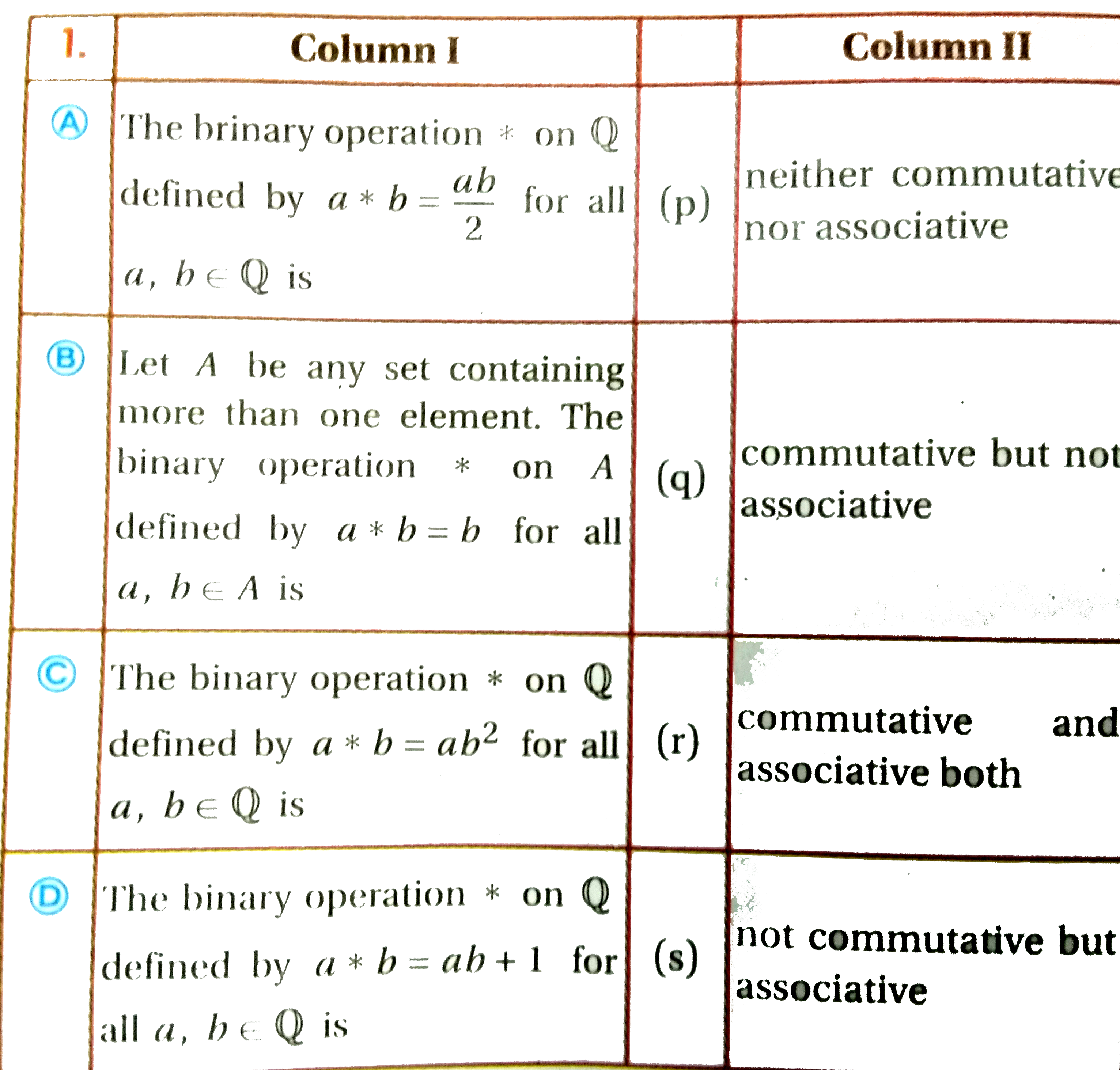Let A=R0×R where R0 denote the set of all non-zero real numbers. A binary operation ∗ is defined on A as follows: (a,b)∗(c,d)=(ac,bc+d) for all (a,b),(c,d)∈R0×R.
Binary operation ∗ is--Identity element in A is--Solution in Bengali
(0,1)
(0,0)
(1,0)
(1,1)
The correct Answer is:C
Step by step video, text & image solution for Let A=RR_(0)xxRR where RR_(0) denote the set of all non-zero real numbers. A binary operation ** is defined on A as follows: (a,b)**(c,d)=(ac,bc+d) for all (a,b),(c,d)inRR_(0)xxRR. Binary operation ** is--Identity element in A is-- by Maths experts to help you in doubts & scoring excellent marks in Class 12 exams.
Updated on:21/07/2023Topper's Solved these Questions
- BINARY OPERATIONBOOK - CHHAYA PUBLICATIONCHAPTER - BINARY OPERATIONEXERCISE - Assertion-Reason Type
2 Videos
- BINARY OPERATIONBOOK - CHHAYA PUBLICATIONCHAPTER - BINARY OPERATIONEXERCISE - Matrix Match Type
2 Videos
- ARCHIVEBOOK - CHHAYA PUBLICATIONCHAPTER - ARCHIVEEXERCISE - JEE Advanced Archive
13 Videos
- BINOMIAL DISTRUTIONBOOK - CHHAYA PUBLICATIONCHAPTER - BINOMIAL DISTRUTIONEXERCISE - ASSERTION-REASON TYPE
2 Videos
Similar Questions
Let S be a non-empty set and P(S) be the power set of the Set S.
Statement -I: Φ is the identity element for union as a binary operation on P(S)
Statement -II: S is the identity element for intersection on P(S).
View SolutionMatch the following Column I and Column II

View SolutionFour persons independently solve a certain problem correctly with probabilities,12,34,14,18 Then the probability that problem is solved correctly by at least one of them is-
View SolutionStatement-I: Under some condition in the random experiment, p and q are the probability of 'success' and probability of 'failure' respectively, then the probability for x success is f(x)=nCxpxqn−x(x=0,1,2,......,n)
Statement-II: Sample space of a random experiment has only two sample points one is success and other is failure.
View SolutionLet A = R × R and * be the binary operation on A defined by (a, b) * (c, d) = (a + c, b + d). Show that * is commutative and associative. Find the identity element for * on A.
View SolutionLet A=N∪{0}×N∪{0} and let * be a binary operation on A defined by (a, b)⋅(c, d)=(a+c, b+d) for all (a, b), (c, d)∈A. Show that * is associative on A.
View SolutionLet R0 denote the set of all non-zero real numbers and let A=R0×R0 . If * is a binary operation on A defined by (a, b)⋅(c, d)=(ac, bd) for all (a, b), (c, d)∈A. Show that * is both commutative and associative on A (ii) Find the identity element in A
View SolutionLet R0 denote the set of all non-zero real numbers and let A=R0×R0 . If * is a binary operation on A defined by (a, b)⋅(c, d)=(ac, bd) for all (a, b), (c, d)∈A. Find the invertible element in A .
View SolutionFor the binary operation * on Z defined by a∗b=a+b+1 the identity element is
View SolutionLet * be a binary operation defined on set Q−{1} by the rule a*b=a+b−ab. Then, the identity element for * is
View SolutionA binary operation ∗ is defined on the set R0 for all non- zero real numbers as a∗b=ab3 for all a,b∈R0, find the identity element in R0.
View SolutionLet A=N∪{0}×N∪{0}, a binary operation ∗ is defined on A by. (a,b)∗(c,d)=(a+c,b+d) for all (a,b),(c,d)∈A. Prove that ∗ is commutative as well as associative on A. Show also that (0,0) is the identity element In A.
View SolutionLet A=N×N, a binary operation ∗ is defined on A by (a,b)∗(c,d)=(ad+bc,bd) for all (a,b),(c,d)∈A. Show that ∗ possesses no identity element in A.
View SolutionLet A=R0×R where R0 denote the set of all non-zero real numbers. A binary operation ∗ is defined on A as follows: (a,b)∗(c,d)=(ac,bc+d) for all (a,b),(c,d)∈R0×R.
Binary operation ∗ is--
View SolutionLet A=R0×R where R0 denote the set of all non-zero real numbers. A binary operation ∗ is defined on A as follows: (a,b)∗(c,d)=(ac,bc+d) for all (a,b),(c,d)∈R0×R.
The inveritible elements in A is---
View Solution
